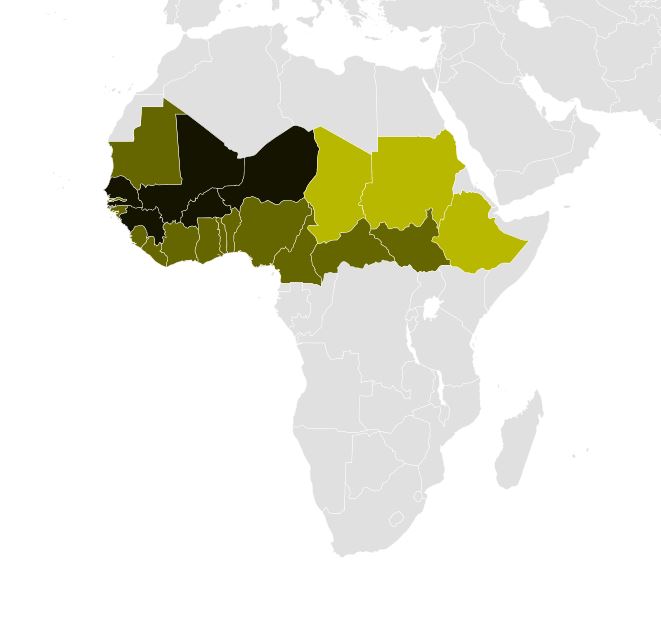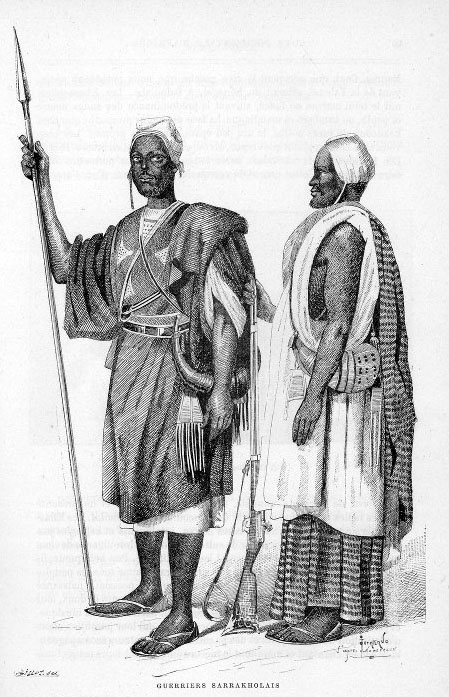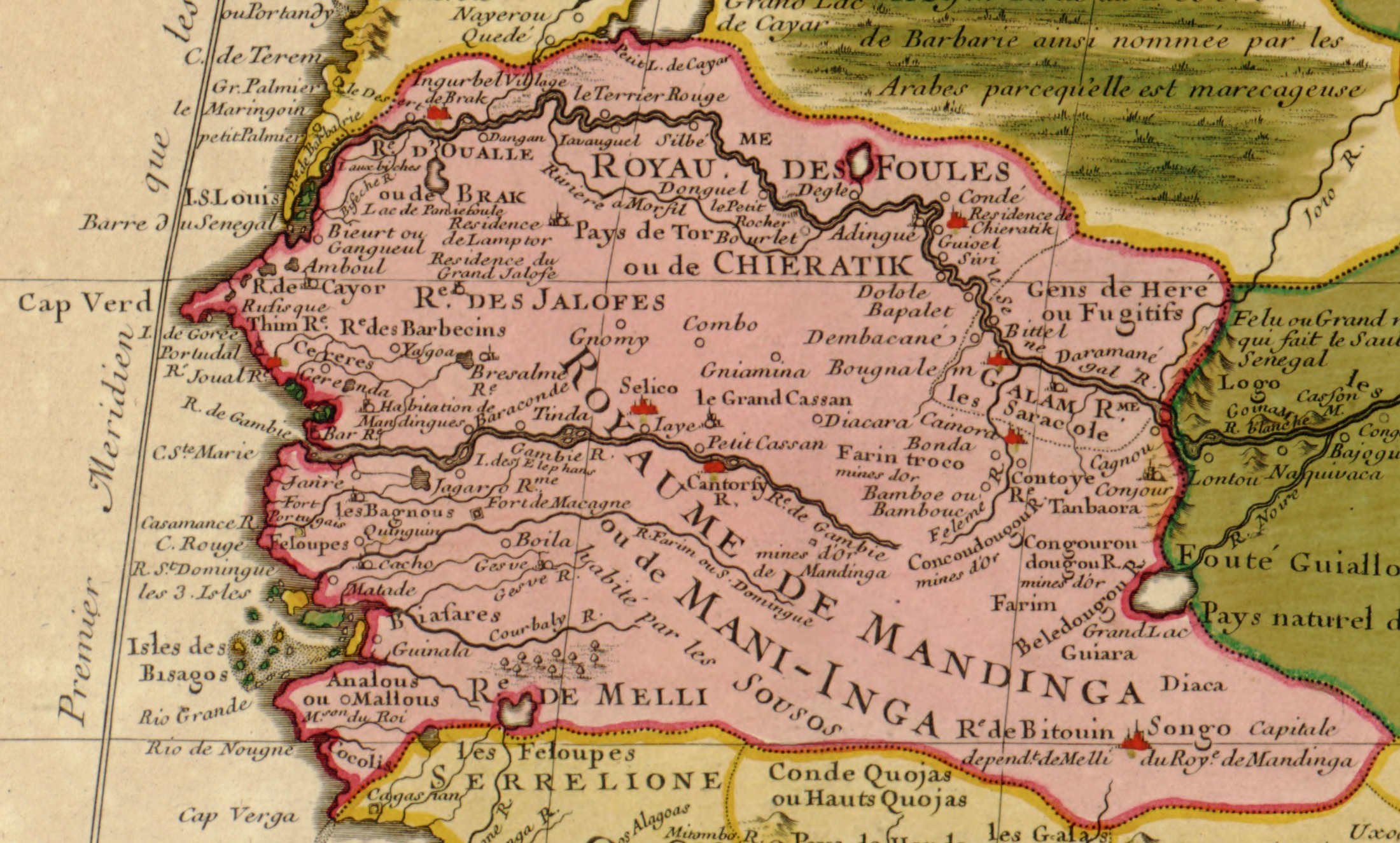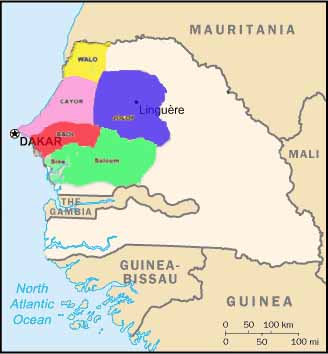|
Bakel, Senegal
Bakel is a town and urban commune, with a population of 18,939, located in the eastern part of Senegal, West Africa. The town is located on the left bank of the Sénégal River, from the Malian border and linked by canoe ferry to the village of Gouraye in Mauritania. Bakel is one of the four eponymous departmental capitals in the region of Tambacounda, the other three being Tambacounda, Goudiry and Koumpentoum. Bakel is known for its French fort (Fort Bakel), which René Caillié visited in 1819. It was also the area where the Mauritanian crisis occurred, a dispute over grazing rights that led to a war between Senegal and Mauritania in 1989. As a result of this conflict, many people around the area moved abroad or emigrated to Senegal. People and Culture The majority of the population belong to the Soninke-speaking ethnic group, a dialect of the larger Mande Languages language family. There is also a substantial Pulaar ( Fula) speaking minority as well as a significant ... [...More Info...] [...Related Items...] OR: [Wikipedia] [Google] [Baidu] |
Communes Of Senegal
The Communes of Senegal are the fourth-level administrative divisions in Senegal (below country, region and department). There are some 121 communes in Senegal which have urban status (''communes de ville''), apart from 46 ''communes d'arrondissement'' in the large towns and 370 List of settlements in Senegal, rural communities (''communautés rurales'') in the countryside. History Dakar Region Dakar Department *Dakar (19 communes d'arrondissement) Guédiawaye Department *Guediawaye (5 communes d'arrondissement) Pikine Department *Pikine (16 communes d'arrondissement) Rufisque Department *Rufisque (3 communes d'arrondissement) *Bargny, Senegal, Bargny *Diamniadio *Sébikhotane *Jaxaay-Parcelle-Niakoul Rap *Sangalkam *Sendou Diourbel Region Bambey Department *Bambey Diourbel Department *Diourbel Mbacké Department *Mbacké Fatick Region Fatick Department *Diakhao *Diofior *Fatick Foundiougne Department *Foundiougne *Karang Poste *Passy (Sénégal), Passy *Sokone *Soum (S ... [...More Info...] [...Related Items...] OR: [Wikipedia] [Google] [Baidu] |
Fula Language
Fula ( ),Laurie Bauer, 2007, ''The Linguistics Student's Handbook'', Edinburgh also known as Fulani ( ) or Fulah (, , ; Adlam script, Adlam: , , ; Ajami script, Ajami: , , ), is a Senegambian languages, Senegambian language spoken by around 36.8 million people as a set of various dialects in a Dialect continuum, continuum that stretches across some 18 countries in West Africa, West and Central Africa. Along with other related languages such as Serer language, Serer and Wolof language, Wolof, it belongs to the Atlantic languages, Atlantic geographic group within Niger–Congo languages, Niger–Congo, and more specifically to the Senegambian languages, Senegambian branch. Unlike most Niger-Congo languages, Fula does not have Tone (linguistics), tones. It is spoken as a first language by the Fula people ("Fulani", ) from the Senegambia, Senegambia region and Guinea to Cameroon, Nigeria, and Sudan and by related groups such as the Toucouleur people in the Senegal River Valley ... [...More Info...] [...Related Items...] OR: [Wikipedia] [Google] [Baidu] |
Bundu (state)
Bundu (also Bondu, Bondou and Boundou) was a state in West Africa existing from the late 17th century until it became a French protectorate dependent on the colony of Senegal. It lay between the Falémé River and the upper course of the Gambia River, that is between 13 and 15 N., and 12 and 13 W. Description The country is an elevated plateau, with hills in the southern and central parts. These are generally unproductive, and covered with stunted wood; but the lower country is fertile, and finely clothed with the baobab, the tamarind and various valuable fruit-trees. Bondu is traversed by torrents, which flow rapidly during the rains but are empty in the dry season. This cites A. Rançon, ''Le Bondou: étude de géographie et d'histoire soudaniennes de 1681 à nos jours'' (Bordeaux, 1894). The name 'Bundu' means 'well' in Pulaar. History Early History Bundu in the 17th century was a sparsely populated part of the kingdom of Gajaaga inhabited mostly by Pulaar communities but ... [...More Info...] [...Related Items...] OR: [Wikipedia] [Google] [Baidu] |
Fula People
The Fula, Fulani, or Fulɓe people are an ethnic group in Sahara, Sahel and West Africa, widely dispersed across the region. Inhabiting many countries, they live mainly in West Africa and northern parts of Central Africa, South Sudan, Darfur, and regions near the Red Sea coast in Sudan. The approximate number of Fula people is unknown, due to clashing definitions regarding Fula ethnicity. Various estimates put the figure between 25 and 40 million people worldwide. A significant proportion of the Fula – a third, or an estimated 7 to 10 million – are pastoralism, pastoralists, and their ethnic group has the largest nomadic pastoral community in the world., Quote: The Fulani form the largest pastoral nomadic group in the world. The Bororo'en are noted for the size of their cattle herds. In addition to fully nomadic groups, however, there are also semisedentary Fulani – Fulbe Laddi – who also farm, although they argue that they do so out of necessity, not choice. The major ... [...More Info...] [...Related Items...] OR: [Wikipedia] [Google] [Baidu] |
Soninke People
The Soninke (Sarakolleh) people are a West African Mande languages, Mande-speaking ethnic group found in Mali, southern Mauritania, eastern Senegal, The Gambia, and Guinea (especially Fouta Djallon). They speak the Soninke language, also called the Serakhulle or Azer language, which is one of the Mande languages. Soninke people were the founders of the ancient Ghana Empire, empire of Ghana or Wagadou c. 200–1240 CE, Subgroups of Soninke include the Jakhanke, Maraka and Soninke Wangara, Wangara. When the Ghana empire was destroyed, the resulting diaspora brought Soninkes to Mali, Mauritania, Senegal, Gambia, Burkina Faso, Côte d'Ivoire, Guinée-Conakry, modern-day Republic of Ghana, Kano in Nigeria, and Guinea-Bissau where some of this trading diaspora was called Wangara, leading to the saying “when Americans landed on the moon, a Soninke was already there” in Senegal, with other versions across West Africa. Predominantly Muslims, the Soninke were one of the early ethnic gr ... [...More Info...] [...Related Items...] OR: [Wikipedia] [Google] [Baidu] |
History Of Senegal
The history of Senegal is commonly divided into a number of periods, encompassing the prehistoric era, the precolonial period, colonialism, and the contemporary era. Paleolithic The earliest evidence of human life is found in the valley of the Falémé River, Falémé in the south-east. The presence of man in the Lower Paleolithic is attested by the discovery of Archaeological industry, stone tools characteristic of Acheulean such as hand axes reported by Théodore Monod at the tip of Fann-Point E-Amitié, Fann in the peninsula of Cap-Vert in 1938, or cleavers found in the south-east. There were also found stones shaped by the Levallois technique, characteristic of the Middle Paleolithic. Mousterian Industry is represented mainly by Scraper (archaeology), scrapers found in the peninsula of Cap-Vert, as well in the low and middle valleys of the Senegal River, Senegal and the Falémé. Some pieces are explicitly linked to hunting, like those found in Tiémassass, near M'Bour, a c ... [...More Info...] [...Related Items...] OR: [Wikipedia] [Google] [Baidu] |
Gajaaga
Gajaaga, also known as Galam, was a Soninke kingdom in on the upper Senegal river that existed from before 1000CE to 1858. The kingdom was mainly located in present day Senegal and some parts of Mali. It was sometimes referred to as the Land of Gold, which it exported in large quantities, and 'Galam' in fact means 'gold' in Wolof. In the middle of the 17th century, Gajaaga was perhaps the most powerful state in the upper Senegal river region. It controlled both banks of the river from the area of Kayes downstream to Bakel. Galam was a vassal of the empire of Jolof and Takrur kingdoms. History The Bacili dynasty established a successor state to the Ghana Empire, preserving the traditional snake cult of Wagadu. They came to the region from the Inner Niger Delta sometime between the 8th and 11th centuries CE and conquered the native 'Gaja' Soninke people, but their control was only truly cemented in the 13th century. At some point Gajaaga became a tributary of the Mali Empire, re ... [...More Info...] [...Related Items...] OR: [Wikipedia] [Google] [Baidu] |
Jolof Empire
The Jolof Empire (), also known as Great Jolof or the Wolof Empire, was a Wolof state in modern-day Senegal, that ruled portions of Mauritania and Gambia from the mid-14th centuryFage, J. D.; Oliver, Roland; "The Cambridge History of Africa." Volume 3. Cambridge University Press, 1975, p. 486, (or possibly earlier) until 1549. Following the battle of Danki, its vassal states were fully or ''de facto'' independent; in this period it is known as the Jolof Kingdom. Origins The region that became Jolof was initially inhabited by the Soce and then Serer peoples, who were driven south by the Wolof by the 13th century. Wolof oral traditions relate that was named after a local chief Jolof Mbengue. The empire consisted mostly of Wolof, Serer and Fula from north of the Senegal River. Before the empire's rise, the region was ruled by Lamanes of the Mbengue, Diaw and Ngom families. They were related to early rulers of neighboring kingdoms such as Baol. Jolof was a vassal of the Mal ... [...More Info...] [...Related Items...] OR: [Wikipedia] [Google] [Baidu] |
Fouta Toro
Futa Toro ( Wolof and , , ; ), often simply the Futa, is a semidesert region around the middle run of the Senegal River. This region, along the border of Senegal and Mauritania, is historically significant as the center of several Fulani states, and a source of jihad armies and migrants to the Fouta Djallon. The word Futa is a general name the Fulbe gave to any area they lived in, while Toro was the actual identity of the region for its inhabitants, likely derived from the ancient kingdom of Takrur. The people of the area mostly speak Pulaar, a dialect of the Fula language that spans West Africa from Senegal to Cameroon. They identified themselves by the language giving rise to the name Haalpulaar'en meaning those who speak Pulaar. The Haalpulaar'en are also known as Toucouleurs (var. ''Tukolor''), a name also derived from of Takrur. Geography The Futa Toro stretches for about 400 kilometers, but only a narrow band of up to 20 kilometers on either side of the Senegal River is ... [...More Info...] [...Related Items...] OR: [Wikipedia] [Google] [Baidu] |
Marabout
In the Muslim world, the marabout () is a Sayyid, descendant of Muhammad (Arabic: سـيّد, Romanization of Arabic, romanized: ''sayyid'' and ''sidi'' in the Maghreb) and a Islam, Muslim religious leader and teacher who historically had the function of a chaplain serving as a part of an Islam and war, Islamic army, notably in North Africa and the Sahara region, in West Africa, and historically in the Maghreb. The marabout is often a scholar of the Quran, or religious teacher. Others may be wandering Asceticism#Islam, holy men who survive on Zakat, alms or as spiritual directors of Muslim religious communities, often as ''Murshid, muršid'' ("guide") of Tariqa, Sufi orders. The term "marabout" is also used for the mausolea of such religious leaders (cf. ''Maqam (shrine), maqām'', ''Mazar (mausoleum), mazār'', in Palestine (region), Palestine also ''Wali, walī/velī''). West Africa Muslim religious teachers Muslim Tariqa, Sufi brotherhoods were one of the main organizing f ... [...More Info...] [...Related Items...] OR: [Wikipedia] [Google] [Baidu] |
Booba
Élie Thitia Yaffa (; born 9 December 1976), better known under his stage name Booba, is a French rapper. After a brief stint as a break dancer in the early 1990s, Booba partnered with his friend Ali to form Lunatic. The duo released a critically acclaimed album in 2000 but disbanded in 2003. Booba has since embarked on a successful solo career, selling more than 10 million discs over his career and becoming the most downloaded artist (legally) in France. Booba is praised for the quality of his flow and beats but often criticized because of the controversial nature of his lyrics. He has also established the rap label Tallac Records, and developed a line of jewellery. Life and career Élie Yaffa was born on 9 December 1976 in the outskirts of Paris in Sèvres. His father is Senegalese and his mother is French of Mosellan and Belgian descent. With his friend Ali they formed the duo Lunatic in 1994. Unable to secure a record deal from a major label because of their contr ... [...More Info...] [...Related Items...] OR: [Wikipedia] [Google] [Baidu] |
Bakel City Gang (born 1945), Dutch conductor
{{disambiguation, geo, surname ...
Bakel may refer to: Places * Bakel Department, Senegal *Bakel, Senegal, a town in the eastern part of Senegal, capital of the Department *Bakel, Netherlands, a village in southern part of the Netherlands *Bakel en Milheeze, a former municipality in the Dutch province of North Brabant, now part of Gemert-Bakel * Bekal, in Kasaragod, India People * John Bakel (born 1972), American fashion designer See also *Gemert-Bakel, Netherlands *Kees Bakels Kees Bakels (born 14 January 1945, in Amsterdam) is a Dutch conductor. Bakels began his musical career as a violinist, and later studied conducting at the Amsterdam Conservatory and the Accademia Musicale Chigiana in Siena, Italy. He has appeare ... [...More Info...] [...Related Items...] OR: [Wikipedia] [Google] [Baidu] |





